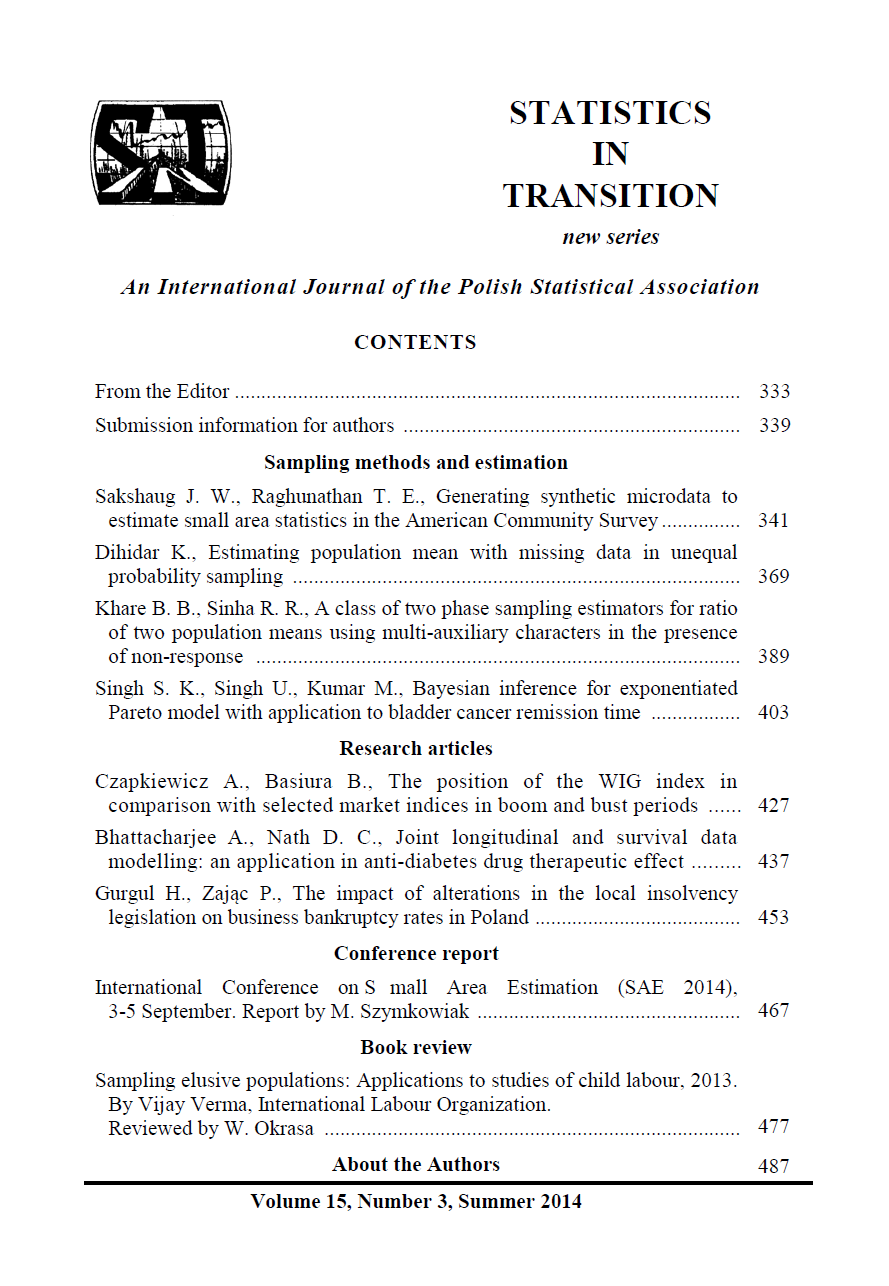ARTICLE
ABSTRACT
Small area estimates provide a critical source of information used to study local populations. Statistical agencies regularly collect data from small areas but are prevented from releasing detailed geographical identifiers in public-use data sets due to disclosure concerns. Alternative data dissemination methods used in practice include releasing summary/aggregate tables, suppressing detailed geographic information in public-use data sets, and accessing restricted data via Research Data Centers. This research examines an alternative method for disseminating microdata that contains more geographical details than are currently being released in public-use data files. Specifically, the method replaces the observed survey values with imputed, or synthetic, values simulated from a hierarchical Bayesian model. Confidentiality protection is enhanced because no actual values are released. The method is demonstrated using restricted data from the 2005-2009 American Community Survey. The analytic validity of the synthetic data is assessed by comparing small area estimates obtained from the synthetic data with those obtained from the observed data.
KEYWORDS
counties, microdata, multiple imputation, data confidentiality.
REFERENCES
ABOWD, J. M., STINSON, M., BENEDETTO, G., (2006). Final Report to the Social Security Administration on the SIPP/SSA/IRS Public Use File Project.http://www.census.gov/sipp/SSAfinal.pdf.
BINDER, D. A., (1983). On the Variances of Asymptotically Normal Estimators from Complex Surveys. International Statistical Review, 51, 279–292.
DATTA, G. S., FAY, R. E., GHOSH, M., (1991). Hierarchical and Empirical Bayes Analysis in Small-Area Estimation. Proceedings of the Annual Research Conference, U. S. Bureau of the Census, 63–78.
DEMPSTER, A. P., LAIRD, N. M., RUBIN, D. B., (1977). Maximum Likelihood from Incomplete Data via the EM Algorithm. Journal of the Royal Statistical Society, Series B, 39, 1–38.
DRECHSLER, J., BENDER, S., RÄSSLER, S., (2008). Comparing Fully and Partially Synthetic Datasets for Statistical Disclosure Control in the German IAB Establishment Panel. Transactions on Data Privacy, 105–130.
FAY, R. E., HERRIOT, R. A. (1979). Estimates of Income for Small Places: An Application of James-Stein Procedures to Census Data. Journal of the American Statistical Association, 74, 269–277.
KARR, A. F., KOHNEN, C. N., OGANIAN, A., REITER, J. P., SANIL, A. P.,(2006). A Framework for Evaluating the Utility of Data Altered to Protect Confidentiality. The American Statistician, 60, 224–232.
KENNICKELL, A. B. (1997). Multiple Imputation and Disclosure Protection: The Case of the 1995 Survey of Consumer Finances. In Record Linkage Techniques. W. Alvey and B. Jamerson (eds.) Washington D. C.: National Academy Press, 248–267.
KINNEY, S. K., REITER, J. P., REZNEK, A. P., MIRANDA, J., JARMIN, R. S., ABOWD, J. M., (2011). Towards Unrestricted Public Use Business Microdata: The Synthetic Longitudinal Business Database. International Statistical Review, 79, 362–384.
LINDLEY, D. V., SMITH, A. F. M., (1972). Bayes Estimates for the Linear Model. Journal of the Royal Statistical Society, Series B, 34, 1–41.
LITTLE, R. J. A., (1993). Statistical Analysis of Masked Data. Journal of Official Statistics, 9, 407–426.
LITTLE, R. J. A., RUBIN, D. B., (2002). Statistical Analysis with Missing Data.2nd Edition. Wiley.
LIU, F., LITTLE, R. J. A., (2002). Selective Multiple Imputation of Keys for Statistical Disclosure Control in Microdata. In ASA Proceedings of the Joint Statistical Meetings, 2, 2133–2138.
MACKIE, C., BRADBURN, N., (2000). Improving Access to and Confidentiality of Research Data: Report of a Workshop. Commission on Behavioral and Social Sciences and Education, National Research Council. National Academy Press, Washington, D. C.
MALEC, D., SEDRANKS, J., MORIARITY, C. L., LECLERE, F. B., (1997).Small Area Inference for Binary Variables in the National Health Interview Survey. Journal of the American Statistical Association, 92, 815–826.
PLATEK, R., RAO, J. N. K., SÄRNDAL, C. E., SINGH, M. P., (1987). Small Area Statistics. Wiley, New York.
RAGHUNATHAN, T. E., RUBIN, D. B., (2000). Bayesian Multiple Imputation to Preserve Confidentiality in Public-Use Data Sets. ISBA 2000 The Sixth World Meeting of the International Society for Bayesian Analysis.
RAGHUNATHAN, T. E., LEPKOWSKI, J. M., VAN HOEWYK, J., SOLENBERGER, P., (2001). A Multivariate Technique for Multiply Imputing Missing Values Using a Sequence of Regression Models. Survey
Methodology, 27, 85–95.
RAGHUNATHAN, T. E, REITER, J. P., RUBIN, D. B., (2003). Multiple Imputation for Statistical Disclosure Limitation. Journal of Official Statistics,19, 1–16.
RAO, J. N. K., (1999). Some Recent Advances in Model-based Small Area Estimation. Survey Methodology, 25, 175–186.
RAO, J. N. K., (2003). Small Area Estimation. Wiley, New York.
REITER, J. P., (2002). Satisfying Disclosure Restrictions with Synthetic Data Sets. Journal of Official Statistics, 18, 531–544.
REITER, J. P., (2003). Inference for Partially Synthetic, Public Use Microdata Sets. Survey Methodology, 29, 181–188.
REITER, J. P., (2004).Simultaneous Use of Multiple Imputation for Missing Data and Disclosure Limitation. Survey Methodology, 30, 235–242.
REITER, J. P., (2005). Releasing Multiply-Imputed, Synthetic Public Use Microdata: An Illustration and Empirical Study. Journal of the Royal Statistical Society, Series A, 168, 185–205.
REITER, J. P., RAGHUNATHAN, T. E., KINNEY, S. K., (2006). The Importance of Modeling the Survey Design in Multiple Imputation for Missing Data. Survey Methodology, 32, 143–150.
REITER, J. P., RAGHUNATHAN, T. E., (2007).The Multiple Adaptations of Multiple Imputation. Journal of the American Statistical Association, 102,1462–1471.
RODRIGUEZ, R., (2007). Synthetic Data Disclosure Control for American Community Survey Group Quarters. In ASA Proceedings of the Joint Statistical Meetings, 1439–1450.
RUBIN, D. B., (1983). A Case-Study of the Robustness of Bayesian/Likelihood Methods of Inference: Estimating the Total in a Finite Population using Transformations to Normality. In Scientific Inference, Data Analysis and Robustness. G.E.P. Box, T. Leonard, and C.F. Wu (eds.) New York: Academic Press, 213–244.
RUBIN, D. B. (1987). Multiple Imputation for Nonresponse in Surveys. Wiley: New York.
RUBIN, D. B., (1993). Satisfying Confidentiality Constraints Through the Use of Synthetic Multiply-Imputed Microdata. Journal of Official Statistics, 9,461–468.
TRANMER, M., PICKLES, A., FIELDHOUSE, E., ELLIOT, M., DALE, A., BROWN, M., MARTIN, D., STEEL, D., GARDINER, C., (2005). The Case for Small Area Microdata. Journal of the Royal Statistical Society: Series A (Statistics in Society), 168, 29–49.
U.S. CENSUS BUREAU, (2009). American Community Survey: Design and Methodology. http://www.census.gov/acs/www/Downloads/survey_methodology/acs_design_methodology.pdf
YUCEL, R. M., (2008). Multiple Imputation Inference for Multivariate Multilevel Continuous Data with Ignorable Non-Response. Philosophical Transactions of the Royal Society A, 366, 2389–2403.
